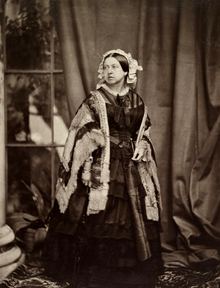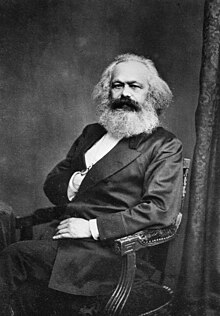John Jabez Edwin Mayall: Difference between revisions
Jamesmcardle (talk | contribs) →Portraits of eminent people: Moving Karl Marx portrait to 'look into' the page |
Jamesmcardle (talk | contribs) →Death: new section and ref |
||
| Line 53: | Line 53: | ||
==Death== |
==Death== |
||
Mayall died, aged 88, on 6 March 1901 at [[Southwick, West Sussex]]. He was buried on 19 March 1901 at [[Lancing, West Sussex]]. |
Mayall died, aged 88, on 6 March 1901 at [[Southwick, West Sussex]]. He was buried on 19 March 1901 at [[Lancing, West Sussex]]. |
||
== Publications == |
|||
* Mayall J. E. 1867. ''Mayall's Celebrities of the London Stage : A Series of Photographic Portraits in Character''. London: Messrs. A. Marion Son.<ref>{{Cite book |last=Mayall |first=J.E. |title=Mayall's celebrities of the London stage : a series of photographic portraits in character |publisher=Messrs. A. Marion Son. |year=1867 |location=London |language=en |oclc=492535993}}</ref> |
|||
==References== |
==References== |
||
Revision as of 06:36, 15 June 2023
This article needs additional citations for verification. (June 2015) |

John Jabez Edwin Paisley Mayall (17 September 1813 near Oldham, Lancashire – 6 March 1901 in Southwick, West Sussex) was an English photographer who in 1860 took the first carte-de-visite photographs of Queen Victoria.[1] He is most well known for his 1875 portrait of Karl Marx.
Born into a Baptist family on 17 September 1813, at Chamber Hall, near Oldham in the county of Lancashire, his birth name was registered as Jabez Meal. He was the son of John and Elizabeth Meal.[citation needed]
West Yorkshire (1833-1842)
North America
In 1846 the partnership between Van Loan and Mayall came to an end. John Mayall then established his own Daguerreotype studio at Fifth and Chestnut Street.[citation needed]
London Daguerreotype art (1846-1860)
High art photography
Mayall and J. M. W. Turner
By August 1848, Mayall placed advertisements describing himself as "Mr. Mayall of Philadelphia, United States." Mayall called his studio/gallery the "American Daguerreotype Institution".
Scenes of Mayall taking Turner's daguerreotype, alone and together with his companion Mrs. Booth, appear in the film Mr. Turner.
The Great Exhibition of 1851
Portraits of eminent people


In May 1860, he made a number of portraits of the Royal Family. Mayall was given permission to publish the portraits of the Royal Family as a set of cartes-de-visite. In August 1860, the cartes were released in the form of a Royal Album, consisting of 14 small portraits of Queen Victoria, Prince Albert and their children. The Royal Album was an immediate success, and hundreds of thousands were sold.[citation needed]
Britain began collecting carte de visite portraits of famous people. Another series of royal portraits by Mayall was published in 1861. Prince Albert succumbed to typhoid fever in December 1861. His death created an enormous demand for his portrait. The Photographic News later reported that within one week of his death "no less than 70,000 of his carte de visite were ordered from Marion & Co." By the end of the decade, Marion & Co, had paid Mayall £35,000 for his portraits of the Royal Family.[citation needed] The carte de visite (cdv) was the most popular of the portrait formats. The cdv also generated the most income. Mayall produced over half a million cartes a year, which helped him secure an annual income of £12,000.[citation needed]
Brighton
He left his eldest son Edwin to run his London studios and moved down to Brighton with his wife and two younger sons. On 18 July 1864, he opened his new photographic portrait studio at 90-91 Kings Road, close to the recently built Grand Hotel. In an announcement placed in the pages of the Brighton Examiner, he stated that he had "spared neither pains nor expertise in preparing, for the accommodation of the nobility and gentry resident at or visiting Brighton, one of the most efficient studios ever built." Although he addressed his comments particularly to the "nobility and gentry", Mayall admitted that he was "not unmindful of the fact . . . that moderate charges are as necessary as general excellence to ensure extensive public patronage." Mayall charged £1.1s for a set of 12 carte de visite portraits and £5.5s for his "highly finished" coloured portrait photographs.[citation needed]
In 1869 his son, John Junior, became the first person to cycle from London to Brighton. According to the Bournemouth Echo (2 May 1903): "John Mayall, Junior, was the first cyclist, or velocipedist as the term then was, to traverse the Brighton road. On 17th February, 1869, he rode a 'boneshaker' from Trafalgar-square to Brighton in about 12 hours."
Mayall's wife Eliza died in Brighton in 1870. The following year, on 14 December 1871 at St George's Bloomsbury, he married Celia Victoria Hooper (1838-1922), widow of timber merchant Henry Morgan Hooper and daughter of surgeon William Gardner. This marriage produced three further children: Elsie Lena (born 1872), Oswald (born 1874) and Sibyl (born 1876).
Mayall the innovator
As a daguerreotype artist, Mayall considered himself to be a pioneer and inventor, He introduced new techniques and novelties into the art of photography.
Giant daguerreotypes and microscopic portraits
Hand-coloured daguerreotypes
Miniature photographs on ivory
Death
Mayall died, aged 88, on 6 March 1901 at Southwick, West Sussex. He was buried on 19 March 1901 at Lancing, West Sussex.
Publications
- Mayall J. E. 1867. Mayall's Celebrities of the London Stage : A Series of Photographic Portraits in Character. London: Messrs. A. Marion Son.[3]
References
- ^ John Plunkett (2003). Queen Victoria: First Media Monarch. Oxford University Press. ISBN 0-19-925392-7.[page needed]
- ^ The New York Times
- ^ Mayall, J.E. (1867). Mayall's celebrities of the London stage : a series of photographic portraits in character. London: Messrs. A. Marion Son. OCLC 492535993.
External links
 Media related to John Jabez Edwin Mayall at Wikimedia Commons
Media related to John Jabez Edwin Mayall at Wikimedia Commons
